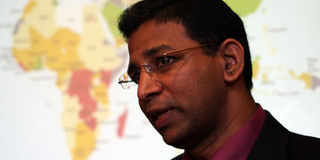Kenya's 'alarming' hunger situation

Suresh Babu Food Security, poverty and Nutrition policy Analysis during the presentation of the 2009 Release of Global Hunger Index Report on October 14, 2009. Liz Muthoni
Kenya is rated among the 30 highest food insecure countries in the world.
According to a Global Hunger Index (GHI) 2009 report released on Wednesday, the trend is moving fast from serious to alarming.
The report, which covers the food situation up to 2007, was officially released Wednesday.
The GHI, a measure of world hunger rates, is calculated using a formula that takes into account the proportion of undernourished in a population, the prevalence of underweight children under the age five, and the proportion of children dying before the age of five.
The result is a number out of 40.
In the report released by the International Food Policy Research Institute (IFPRI), Kenya climbed by 0.2 points up from 20.0 to 20.2 raising the hunger situation to alarming.
While 0.2 out of 40 may seem insignificant, when one considers that the global average GHI has reduced from 20.0 in 1990, to 15.2 in 2009, the severity of Kenya’s situation is apparent.
When a country is rated 30 and above, the situation is extremely alarming, 20-30 is alarming, 10-20 is serious, while 5-10 is moderate.
The situation has been attributed to the 2008 post election violence where the country recorded a massive drop in tourism earnings, climate change and global economic recession.
Worst hit are the slum areas where food prices have increased by more than 100 per cent and Asal areas which, according to the report, has been worst hit by climate change.
According to Dr Suresh Babu, a senior fellow and programme leader with the IFPRI, most parts of the country have received less rainfall with other areas not having rains for the past three seasons thereby accelerating food insecurity.
“In areas like Ukambani, Kajiado and Northern Kenya, the situation has been extremely worse as most farmers have not had an harvest for the past three seasons” he said “some have also lost their animals due to loss of pasture and water”.
Higher temperatures eventually reduce yields of desirable crops while encouraging weed and pest proliferation. Changes in precipitation patterns increase the likelihood of short-run crop failures and long-run production declines.
According to the report, although there will be gains in some crops in some regions of the country, the overall impacts of climate change on agriculture are expected to be negative, threatening food security.
These come at a time when farmers nationwide are anticipating poor harvests due to lack of rain and effects of El Nino threaten most parts of the country.
The situation could worsen as Kenya is already feeling the heat. Dwindling stocks at the national grain stores and the high prices are making it difficult for the growing population of the urban poor to buy food. This is worrying the government and relief agencies who have warned the gloomy situation is deteriorating fast.
The perilous situation could be worsened by the El Nino rains, which brings heavy rains towards the end of the year that produce floods and mudslides, ruining crops, killing livestock and damaging infrastructure, the report says.
In Kenya, the vital maize crop which accounts for 80 per cent of annual cereal production, is forecast 28 per cent below usual levels at 1.84 million tonnes after Western Kenya and Rift Valley which are the country’s grain basket received low rainfall.
According to the government, 10 million people are under the verge of starvation but according to Ms Anne O’Mahony the country director of Concern Worldwide, a leading Germany NGO, the number could be even higher than that by more than 30 percent as many cases go unreported.
“We would look at Kenya today as being a lot more food insecure than this data suggests,” she said, adding that the price of maize has increased by over 100 per cent in urban slums within the last year.
As bad as Kenya’s situation is, it is nowhere near the worst.
Of the ten countries that have seen the largest increase in their GHI scores, nine are in Sub-Saharan Africa.
Worst of all, the Democratic Republic of Congo’s score has increased by 53 per cent, to a 2009 score of 39.1 out of 40.
Burundi and Eritrea are close behind with scores of 38.7 and 36.5, respectively.
“The global financial crisis has had a huge effect on food prices and production, and though we’re just around the corner from the 2015 Millennium Development Goal deadline to reduce the number of hungry people from 800 million, and should be seeing progress, we’re actually seeing the numbers going up,” she said, adding that the current number of hungry people in the world is now closer to 900 million.
While the numbers are alarming, they are likely worse than the data suggests, says Regional Director of Deutsche Welthungerhlife, Iris Krebber.
“In the poorest rural regions, population numbers are consistently 25-30 per cent under-reported. If you extrapolate that, it means that we’re not talking about 800 or 900 million going hungry, but well over a billion,” she said.
Ms Krebber said that Kenya is a nation full of educated individuals with the capabilities to make a difference and ended her presentation by stating: “The facts are there, things are much worse than the numbers in this report indicate. It’s high time to act.”



